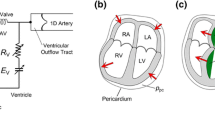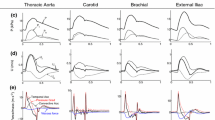Summary
The pulmonary venous systolic flow wave has been attributed both to left heart phenomena, such as left atrial relaxation and descent of the mitral annulus, and to propagation of the pulmonary artery pressure pulse through the pulmonary bed from the right ventricle. In this study we hypothesized that all waves in the pulmonary veins originate in the left heart, and that the gross wave features observed in measurements can be explained simply by wave propagation and reflection. A mathematical model of the pulmonary vein was developed; the pulmonary vein was modeled as a lossless transmission line and the pulmonary bed by a three-element lumped parameter model accounting for viscous losses, compliance, and inertia. We assumed that all pulsations originate in the left atrium (LA), the pressure in the pulmonary bed being constant. The model was validated using pulmonary vein pressure and flow recorded 1 cm proximal to the junction of the vein with the left atrium during aortocoronary bypass surgery. For a pressure drop of 6 mmHg across the pulmonary bed, we found a transit time from the left atrium to the pulmonary bed ofτ ≈ 150ms, a compliance of the pulmonary bed ofC ≈ 0.4ml/mmHg, and an inertance of the pulmonary bed of 1.1mmHgs2/ml. The pulse wave velocity of the pulmonary vein was estimated to bec ≈ 1 m/s. Waves, however, travel both towards the left atrium and towards the pulmonary bed. Waves traveling towards the left atrium are attributed to the reflections caused by the mismatch of impedance of line (pulmonary vein) and load (pulmonary bed). Wave intensity analysis was used to identify a period in systole of net wave propagation towards the left atrium for both measurements and model. The linear separation technique was used to split the pressure into one component traveling from the left atrium to the pulmonary bed and a reflected component propagating from the pulmonary bed to the left atrium. The peak of the reflected pressure wave corresponded well with the positive peak in wave intensity in systole. We conclude that the gross features of the pressure and flow waves in the pulmonary vein can be explained in the following manner: the waves originate in the LA and travel towards the pulmonary bed, where reflections give rise to waves traveling back to the LA. Although the gross features of the measured pressure were captured well by the model predicted pressure, there was still some discrepancy between the two. Thus, other factors initiating or influencing waves traveling towards the LA cannot be excluded.
Similar content being viewed by others
References
Nishimura RA, Abel MD, Hatle LK, Tajik AJ (1990) Relation of pulmonary vein to mitral flow velocities by transesophageal Doppler echocardiography. Effect of different loading conditions. Circulation 81:1488–1497
Caro C, McDonald DA (1961) The relation of pulsatile pressure and flow in the pulmonary vascular bed. J Physiol 157:426–453
Pinkerson AL (1967) Pulse-wave propagation through the pulmonary vascular bed. Am J Physiol 213:450–454
Maloney JE, Bergel DH, Glazier JB, Hughes JMB, West JB (1968) Transmission of pulsatile blood pressure and flow through the isolated lung. Circ Res 23:11–24
Morgan B, Abel F, Mullins G, Guntheroth W (1996) Flow patterns in cavae, pulmonary artery, pulmonary vein, and aorta in intact dogs. Am J Physiol 210:903–909
Rajagopalan B, Friend J, Stallard T, Lee G (1979) Blood flow in pulmonary veins: II. The influence of events transmitted from the right and left sides of the heart. Cardiovasc Res 13:677–683
Milnor WR (1989) Hemodynamics, 2nd edn. Williams and Wilkins, Baltimore
Murgo J, Westerhof N, Giolma J, Altobelli S (1980) Aortic input impedance in normal man: relationship to pressure wave forms. Circulation 62:105–116
Westerhof N, Sipkema P, Van den Bos C, Elzinga G (1972) Forward and backward waves in the arterial system. Cardiovasc Res 6:648–656a
Lighthill J (1978) Waves in fluids. Cambridge University Press, Cambridge chapter 2
Parker K, Jones C, Dawson J, Gibson D (1988) What stops the flow of blood from the heart? Heart Vessels 4:241–245
Parker K, Jones C (1990) Forward and backward running waves in the arteries: analysis using the method of characteristics. J Biomech Eng 112:322–326
Jones CJ, Sugawara M, Davies RH, Kondoh Y, Uchida K, Parker KH (1994) Arterial wave intensity: physical meaning and physiological significance. Harwood Academic Publishers, London, pp 129–148. Tokyo Symposium on Cardiovascular Mechanics, 1991. Recent progress in cardiovascular mechanics
West JB (1990) Best and Taylor's physiological basis of medical practice, 12th edn. Williams and Wilkins, Baltimore, pp 529–531
Azuma T, Masamitsu H (1973) Distensibility of the vein: from the architectural point of view. Biorheology 10:469–479
Fung Y (1984) Biodynamics. Circulation. Springer, Berlin Heidelberg New York
Wesley R, Vaishnav R, Fuchs J, Patel D, Greenfield J Jr (1975) Static linear and nonlinear elastic properties of normal and arterialized venous tissue in dog and man. Circ Res 37:509–520
Anliker M, Wells M, Ogden E (1969) The transmission characteristics of large and small pressure waves in the abdominal vena cava. IEEE Trans Biomed Eng 16:262–273
Stergiopulos N, Meister JJ, Westerhof N (1995) Evaluation of methods for estimation of total arterial compliance. Am J Physiol 4:H1540-H1548
Author information
Authors and Affiliations
Rights and permissions
About this article
Cite this article
Hellevik, L.R., Segers, P., Stergiopulos, N. et al. Mechanism of pulmonary venous pressure and flow waves. Heart Vessels 14, 67–71 (1999). https://doi.org/10.1007/BF02481745
Received:
Revised:
Accepted:
Issue Date:
DOI: https://doi.org/10.1007/BF02481745




